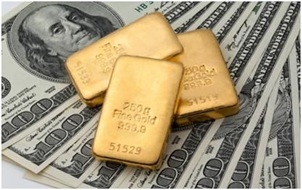The Difference Between Gold And Debt
 The world has added approximately $60 Trillion in debt since 2007, much of it sovereign debt created from deficit spending on social programs, wars, and much more. In that time the world has mined perhaps 30,000 tons of gold, or about 950 million ounces, worth at September 2015 prices a little more than a $Trillion. It is easy to create debt – central banks “print” currencies by BORROWING those currencies into existence. Debt increases, currency in circulation increases, and until it crashes, life is good for the financial and political elite. But debt increasing 60 times more rapidly than gold indicates that debt is growing too rapidly and due for a reset.
The world has added approximately $60 Trillion in debt since 2007, much of it sovereign debt created from deficit spending on social programs, wars, and much more. In that time the world has mined perhaps 30,000 tons of gold, or about 950 million ounces, worth at September 2015 prices a little more than a $Trillion. It is easy to create debt – central banks “print” currencies by BORROWING those currencies into existence. Debt increases, currency in circulation increases, and until it crashes, life is good for the financial and political elite. But debt increasing 60 times more rapidly than gold indicates that debt is growing too rapidly and due for a reset.
It is a tangled web of debt, counter-party risk, obligations, and unintended consequences. From an interview with David Stockman:
Stockman goes on to paint a grim picture and says, “What happens when the financial breakdown comes is there is a great margin call. Everybody says ‘I want my money back and I’ll take your collateral if I don’t get it back. If I do take your collateral, I will sell it for whatever price I can get and cut my losses.’ So, this is truly a house of cards. The whole pyramid of debt and what we call hypothecation and rehypothecation of financial assets, that is the real bubble. That’s what people don’t focus on enough. Sure, you can think of stocks that are a bubble, like Tesla and its current price of around $250, or the biotech index which is trading at hundreds of times earnings is crazy. What’s really crazy is all of this debt that has been created has been turned into collateral and borrowed against at a very high rate. The whole thing is very unstable and tottering as we speak.. . . Much of this collateralized credit that has been created is a confidence game. It is a daisy chain, and when the confidence breaks and they start to unwind the chain, the amount of debt outstanding will shrink. That will create tremendous broken furniture in the financial system.”
How do you protect yourself? Stockman says, “The place to go in my view is cash. Stay short and liquid because we are going into deflationary collapse. We are going into a great reset in the financial markets where inflated asset values are going to be marked down tremendously, bond prices and stock prices. As a result of, that there will be great opportunity after the dislocation runs its course to buy things much cheaper than they are priced today.”
Stockman thinks the whole system unwinds sometime before the 2016 Presidential race is finished. (emphasis mine)
Critical Points Regarding Debt:
- Margin calls come when markets crash, like now.
- Then we discover who has been “swimming naked” as Warren Buffet says.
- The daisy chain of hypothecated and rehypothecated dodgy assets backing massive loans breaks. Counter-party risk can overwhelm the financial system.
- The towering edifice of debt is unstable and survives primarily due to confidence, until confidence crashes as it did seven years ago.
- A collapse in confidence occurs along with a collapse in prices for bonds and stocks. Given that $Trillions in bonds have been inflated to the point of negative and near zero yields, there is downside room for a substantial correction in the 35 year bond bull market.
- When companies float 100 year bonds the bond bubble is nearing its inevitable and ugly end.
- Stocks in the US have corrected or crashed approximately every seven years. The S&P 500 Index hit an all-time high in May of 2015, seven years since its last major high prior to a crash. There is considerable downside ahead, perhaps even if the FED cranks up QE4 and QE5 to levitate the stock market.
- Question: If the Fed is the “buyer of last resort” who does the Fed sell to? The problem with the uncharted monetary territory that the Fed has led the world into is that unpleasant and unintended consequences lie ahead.
From Adrian Ash (Bullion Vault):
“But if the Fed is scared, investors and savers should be doubly so. Central bankers have led us deep into a forest where money does grow on trees, but not [economic] growth or stability, and now they can’t find the way out.”
“When night falls, there’s a very clear risk of panic as investors realize that central bankers, like the markets, are lost in the dark.”
Critical Points Regarding Gold:
- No counter-party risk. There is no daisy chain of hypothecated assets for real physical gold. If you own paper gold, think again about counter-party risk. If you think you own gold but your friendly neighborhood banker has sold, loaned, or leased your gold multiple times, there will be a problem when you wish to withdraw that gold from the labyrinth of that bank. Worse, the banker may have stolen that gold and left an IOU gold in the vault. Of course, some people trust their bankers and are not concerned … fines, indictments, and prosecutions notwithstanding.
- Fort Knox contained 147 million ounces of gold as of the last count … many decades ago. Since the last audit was performed 60 some years ago, there is risk that the Fort Knox Bullion Depository is actually the Fort Knox Delusion. Apparently “trust but verify” is no longer viable, so act accordingly. Confidence in the global monetary system will be shaken if the real contents of Fort Knox are confirmed and are not as claimed, so don’t expect an actual audit to occur.
- Physical gold securely stored outside the banking system has none of the above mentioned problems. The same is true for silver.
I repeat: Gold is Good. Sovereign Debt is Bad.
Gary Christenson
The Deviant Investor

















